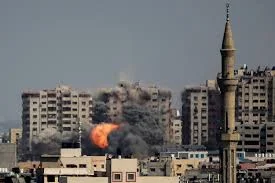Israel-Palestine Conflict: Navigating
the Complexities of the Near East
Introduction
The Israel-Palestine
conflict, often regarded as one of the most intractable disputes in modern
history, has deep-rooted historical, religious, and political complexities. At
the heart of the conflict lies a struggle over territory, identity, and sovereignty,
perpetuated by decades of violence and mutual distrust.
Historical Background
Origins of the Conflict
The roots of the
Israel-Palestine conflict can be traced back to the late 19th and early 20th
centuries, with the rise of Zionism and the subsequent influx of Jewish
immigrants to Palestine. The establishment of the State of Israel in 1948 led
to the displacement of hundreds of thousands of Palestinians, resulting in
widespread resentment and animosity.
Key Events Leading to the Current Situation
From the Arab-Israeli
wars to the Oslo Accords, a series of pivotal events have shaped the trajectory
of the conflict. The Six-Day War in 1967, the Yom Kippur War in 1973, and the
First and Second Intifadas have all left lasting scars on the region, fueling
cycles of violence and retaliation.
Major Players
Israel: A Contested Legacy
Israel, founded as a
homeland for the Jewish people, has faced existential threats since its
inception. Its policies regarding settlements in the occupied territories and
its military actions in Gaza have drawn international condemnation while
garnering staunch support from its allies.
Palestine: Striving for Statehood
The Palestinian
struggle for self-determination has been marked by internal divisions and
external pressures. Despite efforts to establish an independent state,
including numerous peace talks and diplomatic initiatives, the path to
statehood remains elusive.
International Involvement
The involvement of
regional and global powers, including the United States, the European Union,
and Arab states, has both facilitated and complicated efforts to resolve the
conflict. Diplomatic interventions, economic aid, and military support have all
shaped the dynamics of the region.
Root Causes of the Conflict
Territory Disputes
At the heart of the
conflict lies the question of land and borders. The competing claims to
Jerusalem, the West Bank, and Gaza have fueled decades of territorial disputes,
with both sides asserting historical and religious rights to the land.
Religious and Cultural Tensions
Religious narratives,
particularly those tied to Judaism, Islam, and Christianity, play a significant
role in shaping attitudes and perceptions on both sides of the conflict. The
holy sites of Jerusalem, revered by Jews, Muslims, and Christians alike, remain
a focal point of contention.
Political and Economic Factors
Political grievances,
including issues of governance, sovereignty, and self-determination, intersect
with economic disparities and social inequality, exacerbating tensions and
deepening divisions within Israeli and Palestinian societies.
Timeline of Significant Events
conclusion
In conclusion, the
Israel-Palestine conflict remains a complex and multifaceted issue with no easy
solutions. Addressing the root causes of the conflict, fostering dialogue and
reconciliation, and promoting mutual understanding are essential steps towards
achieving lasting peace and stability in the region.




Post a Comment